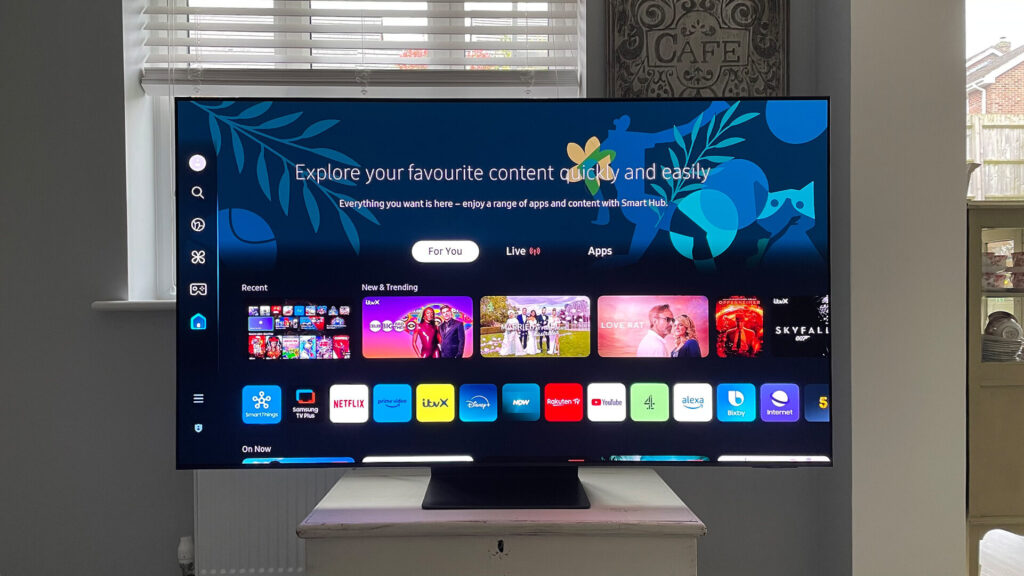Which Samsung 4K Smart TV is Best for You? Vista, Vista Pro, & Infinity Vision Pro Guide
Alright, let’s talk Samsung TVs. Every year, it feels like they drop a new lineup, and 2025 is no different. You’ve probably seen the names floating around: Vista, Vista Pro, and maybe even Infinity Vision Pro. If you’re anything like me, you’ve probably wondered if these are truly different beasts or just the same TV in a different fancy dress. Well, I’ve spent some serious time with these models, and I’m here to cut through the marketing fluff and tell you what’s what.
My mission? To give you the honest truth so you can decide if dropping ₹35,000 to ₹40,000 on one of these is actually worth it. Spoiler alert: they’re more alike than you think. Let’s dive in.
Design & Build Quality: Same Look, Different Remotes
First impressions? These TVs all look pretty much identical. Samsung has gone for a sleek, modern aesthetic with almost invisible bezels on three sides. The bottom bezel is a bit thicker, which is perfectly normal and houses the Samsung branding. The entire body, including the back and frame, is made of plastic. It feels sturdy enough, so no real complaints there. Whether you want to table mount or wall mount, the installation team will provide the necessary stand free of charge, which is a nice touch.
The Remote Control Saga: Where the Real Differences Lie
Here’s where the “different models” actually diverge. It’s all about the remote, and where you buy the TV:
- Samsung Vista: This is your baseline model, typically found on Amazon. It comes with a normal, sleek remote. It’s functional, but it lacks a voice assistant and solar charging.
- Samsung Vista Pro: Step up to this one, also generally on Amazon, and you get the fancy solar charging remote with a built-in voice assistant. In my opinion, the extra ₹3,000 or so you might pay for this upgrade is totally worth it for the convenience.
- Samsung Infinity Vision Pro: This one is usually exclusive to Flipkart. It comes with a voice assistant remote, similar to the Vista Pro, but it surprisingly misses out on the solar charging feature. So, if solar charging is a must-have for you, pay attention to which model you’re ordering!
Beyond the remote, the physical design and build are consistent across all three. So, don’t expect a different looking TV just because of the name.
Picture Quality: The VA Panel Story
This is the heart of any TV, right? And here’s the big news: whether you pick Vista, Vista Pro, or Infinity Vision Pro, you’re getting the exact same 8-bit FRC VA DLED panel. This is a significant change from last year’s models, which sometimes used IPS panels in larger sizes. This year, it’s VA across the board, regardless of size.
Brightness: Good Enough for Most
Let’s be honest, Samsung’s entry-level 4K models aren’t going to blow you away with blinding brightness. I measured the peak sustained brightness at around 230 nits for the Vista and 260 nits for the Vista Pro. HDR peak brightness can hit about 300 nits. This is what I’d call “average.” It’s not bad, but it’s not going to make your content pop in a brightly lit room like some higher-end TVs might.
Contrast & Blacks: A VA Panel’s Strength
Since these are VA panels, you can expect pretty good contrast. I saw contrast ratios of 2550:1 for Vista and 2850:1 for Vista Pro. What does that mean for you? Very good blacks. When you switch on Samsung’s “Contrast Enhancer” feature (and I recommend keeping it on “High”), the blacks get even deeper, and the overall picture quality really shines. You won’t see a lot of blooming, which is great for a budget TV.
Colors: Punchy, But Not Always Natural
The color gamut checks in at 99% sRGB and 76% DCI-P3. This translates to quite a bit of color oversaturation, particularly in blues and reds. Now, Samsung has a history of oversaturating blue to create an illusion of higher brightness, and they’ve leaned into that even more this year. Is it natural? Not exactly. Does it look bad? Not at all. In fact, many people prefer this punchy, vibrant look. You get a good range of colors, clarity, and depth, making content enjoyable.
Viewing Angles: Stay Front and Center
As with most VA panels, viewing angles aren’t their strong suit. If you move off-center, say more than 45 degrees, you’ll start to notice a roughly 30% loss in color and brightness. So, for the best experience, try to watch these TVs head-on.
Smart Features & Connectivity: Tizen OS and Familiar Ports
Samsung’s Tizen OS is what you’ll find here, and it’s generally a fast, light, and responsive operating system. It comes with most major OTT apps pre-downloaded, though the app store itself might not have the widest selection. A neat bonus is Samsung TV Plus, which gives you free live news and entertainment channels, potentially letting you ditch that set-top box.
OS Upgrades: A Welcome Change
In a win for consumers, Samsung has started offering free OS upgrades for these models, likely in response to competition. This means your TV’s smart features should stay updated for longer, which is a definite plus.
Connectivity: Time for an Upgrade, Samsung?
Connectivity inputs remain largely the same as previous years: three HDMI ports (one with eARC), one USB port, one optical port, Bluetooth 5.0, and dual-band WiFi. While functional, I do think it’s time for Samsung to step up their game here. Four HDMI ports and two USB ports would be a much-needed improvement in 2025.
HDR Performance: No Dolby Vision, No Problem?
This is a classic Samsung move: no Dolby Vision support. No matter how high-end a Samsung TV you buy, you won’t get it. These TVs support HDR10, HDR10+, and HLG. But here’s the thing: Samsung’s mastery of its own HDR10+ format is truly impressive. Content in HDR10+ looks magnificent, with amazing clarity, depth, and dynamic range. Even Netflix content, which is often in Dolby Vision, will play in HDR, and it still looks great. So, while the lack of Dolby Vision is a “con” on paper, in real-world viewing, it may not be a deal-breaker for most.
Upscaling Prowess: Decent for SD, Great for HD
When it comes to upscaling, these TVs do a decent job. SD channels, especially news, look okay on the large 4K screen. You’ll be “decently satisfied.” But switch to HD channels, and that’s where these TVs shine. HD content is upscaled so well, it often looks like native 4K. I’m genuinely impressed with the upscaling performance here.
Gaming Experience: For the Casual Player
If you’re a casual gamer, these TVs are a good option. They feature Auto Low Latency Mode (ALLM) which automatically kicks in when you connect a console like a PS5, reducing input lag. You can enjoy HDR gaming, and while you won’t get VRR (Variable Refresh Rate) or 120Hz support, the input lag is a respectable 32-16 milliseconds. If you’re playing 60Hz games once or twice a week for fun, you’ll be perfectly happy.
Audio Quality: Crisp and Clear Dialogues
The audio department sees no major changes either. You get 20W down-firing speakers. While they won’t give you booming bass, they are crisp, loud, and most importantly, they deliver dialogues with excellent clarity. You won’t miss a single word, which is crucial for enjoying movies and shows. There’s also the Q Symphony feature, which lets you pair a compatible Samsung soundbar to work in conjunction with the TV’s speakers for a more immersive sound, though I’m not sure why you’d want to do that with a budget TV.
The Downsides: A Few Niggles to Consider
- No Dolby Vision: This is a consistent Samsung characteristic. While HDR10+ is good, some might prefer the wider adoption of Dolby Vision.
- Average Brightness: At 250-300 nits, it’s not the brightest TV on the block. In very bright rooms, reflections might be an issue.
- Color Oversaturation: While it makes colors pop, it’s not always true to life. This could be a pro or a con depending on your preference for natural vs. vibrant colors.
- Limited Connectivity: Only three HDMI and one USB port feels a bit restrictive in today’s multi-device world.
The Final Verdict: Who Should (and Shouldn’t) Buy This?
After all the testing and nitpicking, my overall rating for these Samsung 4K entry-level TVs (Vista, Vista Pro, Infinity Vision Pro) remains a solid 7.65 out of 10. This rating hasn’t changed much from previous years, mainly because while the panel itself is new, the incremental improvements in picture quality aren’t groundbreaking. However, that doesn’t mean they’re not good TVs for their price point.
Who Should Buy This:
- If you’re looking for a reliable, feature-packed 4K TV from a reputable brand at a budget-friendly price.
- If you primarily watch content from streaming services and HD channels, as the upscaling is excellent.
- If you’re a casual gamer who plays 60Hz games and doesn’t need advanced features like VRR.
- If you appreciate punchy, vibrant colors, even if they lean towards oversaturation.
- If you value crisp, clear dialogue from the built-in speakers.
- If the solar charging remote (with Vista Pro) appeals to your convenience factor.
Who Shouldn’t Buy This:
- If you’re a hardcore gamer who needs 120Hz refresh rates and VRR.
- If you absolutely require Dolby Vision support for your content.
- If you watch a lot of content in very brightly lit rooms and need exceptionally high peak brightness.
- If you’re a stickler for perfectly natural, un-oversaturated colors.
- If you need more than three HDMI ports for your various devices.
Ultimately, these Samsung TVs offer a strong package for their price. They might not be groundbreaking, but they deliver a very enjoyable viewing experience for the average user. Just be clear on which remote version you want, and you’ll likely be quite satisfied.

